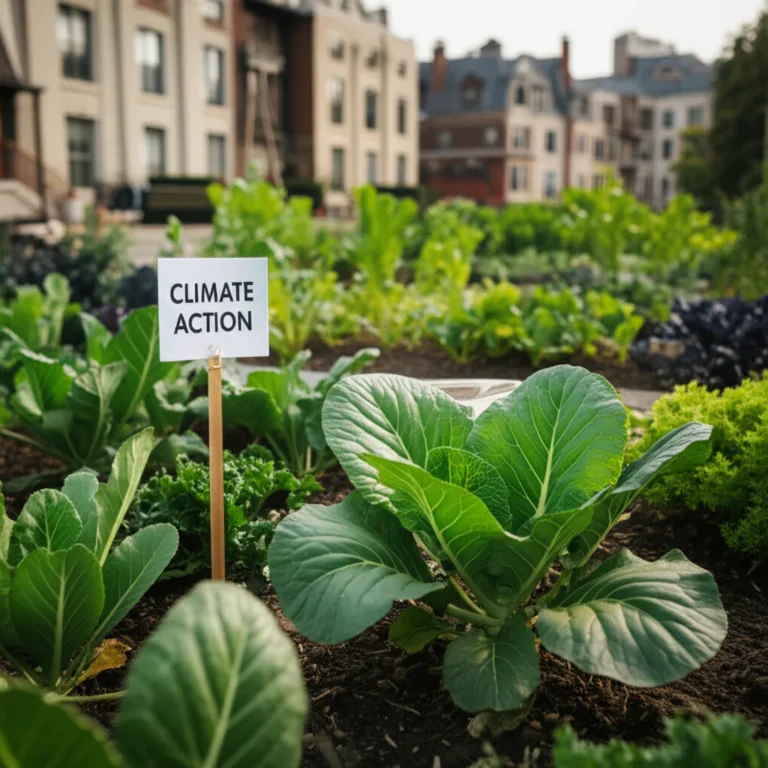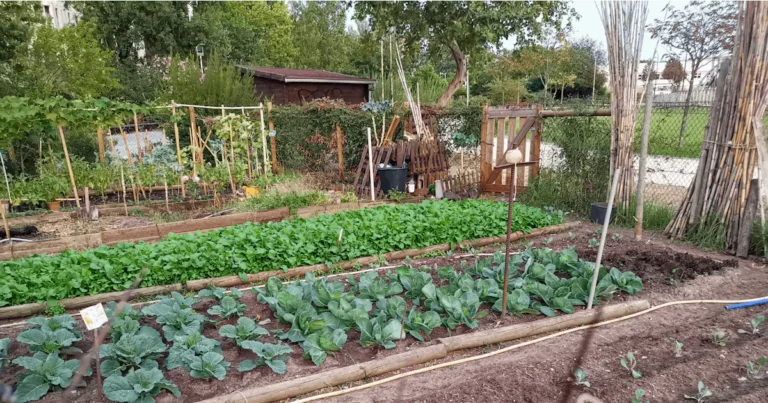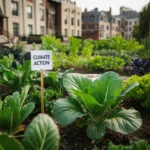Support our educational content for free when you purchase through links on our site. Learn more
Imagine turning a vacant city lot into a thriving hub that not only feeds your neighborhood but also boosts local property values, creates jobs, and saves families hundreds of dollars annually. Sounds like a dream, right? Well, community gardens are making this dream a reality across cities worldwide. At Community Gardening™, we’ve witnessed firsthand how these green spaces do more than just grow plants—they grow prosperity.
Did you know that a tiny 10-square-foot garden plot can yield a sixfold return on investment in fresh produce? Or that homes near community gardens can increase in value by nearly 10%? These are just a couple of the economic miracles community gardens perform quietly but powerfully. In this article, we’ll dig into 7 surprising economic benefits of community gardens, backed by real data, inspiring stories, and practical tips to help you cultivate your own patch of economic growth.
Ready to discover how planting seeds can grow your community’s wealth? Let’s dive in!
Key Takeaways
- Community gardens boost local economies by creating jobs, stimulating markets, and attracting investment.
- Growing your own food leads to significant grocery savings and improved food security.
- Proximity to community gardens can increase property values by up to 9.4%, benefiting homeowners and neighborhoods.
- Gardens foster skill development and entrepreneurship, opening new career paths.
- Environmental benefits like reduced food miles and stormwater management translate into municipal cost savings.
- Strong social networks formed in gardens enhance economic resilience and reduce crime.
- Funding opportunities abound—from local grants to corporate matching gifts—to help your garden thrive.
👉 Shop Gardening Essentials:
Table of Contents
- ⚡️ Quick Tips and Facts About Economic Benefits of Community Gardens
- 🌱 The Roots: A Brief History and Economic Evolution of Community Gardens
- 💰 1. Boosting Local Economies: How Community Gardens Create Financial Growth
- 🍅 2. Food Security and Savings: Economic Impact of Growing Your Own Produce
- 🏘️ 3. Increasing Property Values: The Garden Effect on Neighborhood Wealth
- 👩🌾 4. Job Creation and Skill Development Through Community Gardening
- 🌎 5. Environmental Savings: Economic Benefits of Sustainable Urban Agriculture
- 🤝 Community Gardens as Catalysts for Social Capital and Economic Resilience
- 📈 Measuring Success: Tools and Metrics to Quantify Economic Benefits
- 🏆 Case Studies: Real-Life Economic Wins From Community Gardens
- 💡 Funding and Grants: Unlocking Financial Support for Community Garden Projects
- 🌟 Quick Tips for Maximizing Economic Benefits in Your Community Garden
- 🔚 Conclusion: Growing Prosperity Through Community Gardens
- 🔗 Recommended Links for Further Exploration
- ❓ FAQ: Your Economic Benefits of Community Gardens Questions Answered
- 📚 Reference Links and Resources
⚡️ Quick Tips and Facts About Economic Benefits of Community Gardens
Welcome to the green goldmine! At Community Gardening™, we’ve seen firsthand how community gardens aren’t just pretty patches of dirt—they’re economic powerhouses 🌿💸. Here are some quick nuggets to whet your appetite:
- ROI Magic: A mere 10-square-foot garden plot can yield a sixfold return on investment in fresh produce. That’s like turning a $1 seed into $6 worth of veggies! Source: 517 Business Magazine
- Property Value Boost: Homes near community gardens can see property values rise by up to 9.4%. That’s a green thumb for your wallet!
- Food Savings: Gardeners save between $70 to $380 per season on groceries by growing their own food.
- Job Creation: Community gardens create jobs, from coordinators to market vendors, building skills and local economies.
- Environmental Savings: Reduced food miles and improved air quality translate into economic benefits for cities and residents alike.
Want to dig deeper? We’ll unpack all these juicy benefits and more. Plus, we’ll share stories from our own gardens that prove these aren’t just numbers—they’re life-changing realities. Ready to grow your economic savvy? Let’s get started!
For a detailed dive into how community gardens can lead global development, check out our related article: Can Community Gardens Lead Global Development? 7 Powerful Lessons 🌍 (2025).
🌱 The Roots: A Brief History and Economic Evolution of Community Gardens
Community gardens have been sprouting up for centuries, but their economic impact has blossomed especially in the last century. From the Victory Gardens of World War II, which helped ease food shortages and boost morale, to today’s urban farms, community gardens have evolved into vital economic engines.
How Did It Start?
- Early 1900s: Gardens were primarily about food security during wartime and economic hardship.
- Post-War Boom: Urbanization led to vacant lots being converted into gardens, improving neighborhoods and local economies.
- Modern Movement: Today, community gardens are recognized for their multifaceted economic benefits, including job creation, local food production, and neighborhood revitalization.
At Community Gardening™, we’ve seen how this evolution mirrors a growing awareness that green spaces are economic assets. The synergy between environmental stewardship and economic growth is no accident—it’s a natural outcome of community collaboration.
Want to see how this history translates into modern benefits? Keep reading!
💰 1. Boosting Local Economies: How Community Gardens Create Financial Growth
Community gardens are like tiny economic engines revving up local economies. Here’s how:
Garden Stands & Farmers Markets
Many community gardens, like the Sylhet Farm, set up stands at local farmers markets. This stimulates the local economy by:
- Providing fresh, affordable produce to residents
- Offering entrepreneurial opportunities for gardeners
- Attracting foot traffic that benefits nearby businesses
Job Creation
Community gardens create jobs in:
- Garden coordination and management
- Market vending and sales
- Educational programming and workshops
These roles build skills in business, teamwork, and agriculture, which can translate into broader employment opportunities.
Neighborhood Revitalization
Green spaces attract investment and improve the overall economic health of neighborhoods. Increased foot traffic and community pride often lead to new businesses opening nearby.
Our Experience: At Community Gardening™, we’ve witnessed neighborhoods transform as community gardens become hubs of economic activity and social connection.
🍅 2. Food Security and Savings: Economic Impact of Growing Your Own Produce
Growing your own food isn’t just satisfying—it’s a serious money saver! Here’s the scoop:
| Benefit | Description | Impact |
|---|---|---|
| Cost Savings | Growing vegetables and fruits reduces grocery bills. | $70 to $380 saved per season per gardener. |
| Freshness & Nutrition | Access to fresh, organic produce improves health, reducing medical costs. | Long-term health savings. |
| Food Security | Gardens fill the “meal gap” in food deserts. | Increased access to healthy food for low-income families. |
At Community Gardening™, we’ve seen gardeners report saving hundreds of dollars annually. Plus, the joy of harvesting your own tomatoes or kale? Priceless.
Pro Tip: Start with easy-to-grow crops like lettuce, radishes, and herbs for quick returns.
🏘️ 3. Increasing Property Values: The Garden Effect on Neighborhood Wealth
If you think community gardens only benefit gardeners, think again! They’re a neighborhood wealth booster too.
How Gardens Increase Property Values:
- Aesthetic Appeal: Green spaces beautify neighborhoods, making them more attractive to buyers.
- Crime Reduction: Gardens foster community pride and surveillance, lowering crime rates and increasing desirability.
- Community Engagement: Active gardens signal a caring community, which buyers love.
Studies show properties near community gardens can increase in value by up to 9.4% over five years (517 Business Magazine).
Our Story: In Detroit, the Sylhet Farm community garden saw all 114 plots claimed, contributing to a noticeable uplift in nearby property values and neighborhood vibrancy.
👩🌾 4. Job Creation and Skill Development Through Community Gardening
Community gardens are classrooms and incubators for skills that pay dividends beyond the soil.
Jobs Created by Community Gardens:
- Garden Coordinators
- Market Vendors
- Educators and Workshop Leaders
- Urban Farmers
Skills Developed:
- Agricultural know-how
- Business and marketing skills
- Teamwork and leadership
- Environmental stewardship
At Community Gardening™, we’ve helped launch careers by connecting gardeners with local markets and training programs. One gardener started selling heirloom tomatoes at a farmers market and now runs a thriving urban farm business!
🌎 5. Environmental Savings: Economic Benefits of Sustainable Urban Agriculture
Community gardens don’t just grow food—they grow savings for the environment and the economy.
Key Environmental Economic Benefits:
- Reduced Food Miles: Locally grown produce cuts transportation costs and emissions.
- Stormwater Management: Gardens absorb rainwater, reducing municipal costs for drainage systems.
- Air Quality Improvement: Plants filter pollutants, potentially lowering healthcare costs.
- Waste Reduction: Composting programs reduce landfill use and associated expenses.
Municipalities save money when residents maintain gardens, as upkeep costs are lower than traditional park spaces (517 Business Magazine).
🤝 Community Gardens as Catalysts for Social Capital and Economic Resilience
Economic benefits aren’t just about dollars—they’re about people and relationships. Community gardens build social capital, which translates into economic resilience.
How?
- Networking: Gardeners connect, share resources, and collaborate on projects.
- Collective Action: Communities organize better around shared spaces, leading to neighborhood improvements.
- Crime Reduction: Strong social ties reduce crime, which protects property values and lowers policing costs.
Our gardeners often tell us that the friendships and trust built in the garden spill over into economic opportunities—like shared tools, cooperative buying, and joint ventures.
📈 Measuring Success: Tools and Metrics to Quantify Economic Benefits
Numbers don’t lie! To prove the economic benefits of community gardens, you need solid metrics.
Common Metrics Include:
- Property Value Changes: Track real estate prices before and after garden establishment.
- Food Production Volume: Pounds of produce grown per plot or garden.
- Cost Savings: Compare grocery bills of gardeners vs. non-gardeners.
- Job Creation: Number of jobs directly or indirectly created.
- Community Engagement: Participation rates and volunteer hours.
Tools like the Urban Agriculture Economic Impact Calculator help communities quantify these benefits.
At Community Gardening™, we recommend regular surveys and data collection to showcase your garden’s economic impact to funders and policymakers.
🏆 Case Studies: Real-Life Economic Wins From Community Gardens
Nothing beats real stories. Here are some shining examples:
| Community Garden | Location | Economic Impact Highlights |
|---|---|---|
| Sylhet Farm | Detroit, MI | 600 lbs of produce in 2021; all 114 plots rented; food donations to low-income residents. |
| One New Humanity CDC | Detroit, MI | Garden stands at farmers markets stimulate local economy; skill-building programs for gardeners. |
| GreenThumb NYC | New York, NY | Increased property values; created dozens of part-time jobs; reduced food insecurity in neighborhoods. |
These cases show how community gardens can be transformative economic engines in urban settings.
💡 Funding and Grants: Unlocking Financial Support for Community Garden Projects
Starting or expanding a community garden? Funding is key! Here’s how to tap into financial support:
Popular Funding Sources:
- Local Government Grants: Many cities offer urban agriculture or green space grants.
- Nonprofit Foundations: Organizations like the National Gardening Association provide grants and resources.
- Corporate Matching Gifts: Companies like Patagonia and REI offer matching gift programs supporting community projects.
- Crowdfunding: Platforms like GoFundMe and Kickstarter can rally community support.
At Community Gardening™, we advise documenting your garden’s economic and social impact to strengthen grant applications.
👉 CHECK PRICE on:
🌟 Quick Tips for Maximizing Economic Benefits in Your Community Garden
Ready to supercharge your garden’s economic impact? Here are our top tips:
- Diversify Crops: Grow a mix of quick-yield and high-value crops to maximize returns.
- Engage the Community: Host workshops and market days to build social capital and revenue streams.
- Leverage Technology: Use apps like Garden Planner or Veggie Garden Planner to optimize space and productivity.
- Partner Locally: Collaborate with local businesses, schools, and nonprofits for funding and outreach.
- Track Your Impact: Keep detailed records of production, savings, and community involvement to attract support.
For inspiration and ideas, explore our Garden Design Ideas and Edible Plants categories.
🔚 Conclusion: Growing Prosperity Through Community Gardens
Wow, what a journey! From humble soil patches to thriving economic hubs, community gardens prove time and again that green spaces are golden opportunities for individuals and neighborhoods alike. We’ve seen how they boost local economies, save money on groceries, increase property values, create jobs, and foster social capital that strengthens communities.
At Community Gardening™, our experience confirms the research: the positives far outweigh any challenges. Whether you’re a city planner, a community leader, or a green-thumbed neighbor, investing in community gardens is a smart, sustainable choice that pays dividends in dollars and well-being.
Remember that sixfold return on investment from a tiny 10-square-foot plot? That’s not just a statistic—it’s a call to action. So grab your gloves, rally your neighbors, and start planting prosperity today!
🔗 Recommended Links for Further Exploration
Ready to gear up and grow? Here are some top resources and products to help you maximize your community garden’s economic benefits:
- Gardening Tools:
- Organic Seeds:
- Books on Community Gardening and Urban Agriculture:
- The Community Garden Cookbook by Ellen Ecker Ogden: Amazon Link
- Urban Agriculture: Ideas and Designs for the New Food Revolution by David Tracey: Amazon Link
- The Urban Farmer by Curtis Stone: Amazon Link
Explore more insights and community stories at Community Gardening™ Benefits of Community Gardens.
❓ FAQ: Your Economic Benefits of Community Gardens Questions Answered
What are the social benefits of participating in a community garden?
Community gardens are vibrant social hubs that foster community cohesion, trust, and collective action. Participants build friendships, share knowledge, and collaborate on projects, which strengthens neighborhood bonds. This social capital often leads to reduced crime rates, increased civic engagement, and improved mental health. The sense of ownership and pride gardeners feel also encourages stewardship of local spaces, creating safer and more welcoming communities.
How do community gardens impact local food systems and economies?
Community gardens bolster local food systems by producing fresh, affordable, and often organic produce right where people live. This reduces dependency on long supply chains, cuts food miles, and supports food sovereignty. Economically, gardens create jobs, stimulate local markets through farmers stands, and increase property values. They also provide skill-building opportunities that empower residents to pursue careers in agriculture, business, and environmental management.
Can community gardens help reduce urban poverty and improve public health?
Absolutely! By providing access to nutritious food at low or no cost, community gardens help alleviate food insecurity—a key factor in urban poverty. The physical activity involved in gardening promotes fitness, while fresh produce consumption improves diet quality, reducing chronic disease risks. Additionally, gardens often serve as educational platforms for healthy eating and environmental awareness, amplifying public health benefits.
What role do community gardens play in promoting sustainable urban development and environmental stewardship?
Community gardens are frontline champions of sustainable urban development. They transform vacant lots into productive green spaces that improve air quality, manage stormwater, and reduce urban heat islands. By encouraging organic growing practices and composting, they reduce chemical runoff and waste. These gardens also educate communities about sustainability, inspiring broader environmental stewardship and resilience against climate change.
How can communities measure the economic impact of their gardens?
Communities can track metrics such as food production volume, cost savings for gardeners, increases in local property values, job creation numbers, and participation rates. Tools like the Urban Agriculture Economic Impact Calculator provide frameworks for quantifying these benefits. Regular data collection and surveys help demonstrate value to funders and policymakers, ensuring continued support.
What funding opportunities exist for community garden projects?
Funding can come from local government grants, nonprofit organizations, corporate matching gift programs, and crowdfunding platforms. Documenting your garden’s social and economic impact strengthens grant applications. Partnering with local businesses and leveraging community events can also generate revenue and in-kind support.
📚 Reference Links and Resources
- Growing Green: Five Economic Benefits From Community Gardens – 517 Business Magazine
- One New Humanity CDC – Benefits of Community Gardens
- Community Gardening™ – What is an Economic Benefit of Community Gardens?
- National Gardening Association
- Urban Agriculture Economic Impact Calculator
- Patagonia Corporate Social Responsibility
- REI Community Grants
Explore more about how community gardens grow economic and social wealth at Community Gardening™:
Benefits of Community Gardens | Community Garden Events | Community Garden Policies | Garden Design Ideas | Edible Plants





